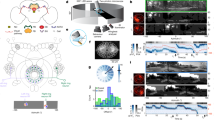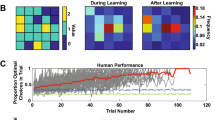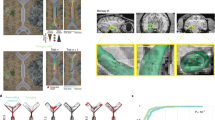Abstract
Under some circumstances, Diptera and Hymenoptera learn visual shapes retinotopically, so that they only recognize the shape when it is viewed by the same region of retina that was exposed to it during learning1,2. One use of such retinotopically stored views is in guiding an insect's path to a familiar site3,4,5. Because the retinal image of an object changes with viewing distance and (sometimes) direction, a single stored view may be insufficient to guide an insect from start to goal. Little, however, is known about the number of views that insects store. Here we show that wood ants take several ‘snapshots’ of a familiar beacon from different vantage points. An ant leaving a newly discovered food source at the base of a landmark performs a tortuous walk back to its nest during which it periodically turns back and faces the landmark. The ant, on revisiting the familiar landmark, holds the edges of the landmark's image steady at several discrete positions on its retina. These preferred retinal positions tend to match the positions of landmark edges that the ant captured during its preceding ‘learning walks’.
This is a preview of subscription content, access via your institution
Access options
Subscribe to this journal
Receive 51 print issues and online access
$199.00 per year
only $3.90 per issue
Buy this article
- Purchase on Springer Link
- Instant access to full article PDF
Prices may be subject to local taxes which are calculated during checkout





Similar content being viewed by others
References
Dill, M., Wolf, R. & Heisenberg, M. Visual pattern recognition in Drosophila involves retinotopic matching. Nature 365, 751–753 (1993).
Wehner, R. in Handbook of Sensory Physiology Vol. VII/6C (ed. Autrum, H.) 287–616 (Springer, Berlin, Heidelberg, New York, 1981).
Collett, T. S. & Land, M. F. Visual spatial memory in a hoverfly. J. Comp. Physiol. 100, 59–84 (1975).
Wehner, R. & Räber, F. Visual spatial memory in desert ants, Cataglyphis fortis (Hymenoptera, Formicidae). Experientia 35, 1569–1571 (1979).
Cartwright, B. A. & Collett, T. S. Landmark learning in bees: experiments and models. J. Comp. Physiol. 151, 521–543 (1983).
Zollikofer, C. P. E., Wehner, R. & Fukushi, T. Optical scaling in conspecific Cataglyphis ants. J. Exp. Biol. 198, 1637–1646 (1995).
Vollbehr, J. Zur Orientierung junger Honigbienen bei ihrem ersten Orientierungsflug. Zool. Jb. 79, 33–69 (1975).
Zeil, J. Orientation flights of solitary wasps (Cerceris; Sphecidae; Hymenoptera): I. Description of flight. J. Comp. Physiol. A172, 189–205 (1993).
Lehrer, M. Why do bees turn back and look? J. Comp. Physiol. A172, 549–563 (1993).
Collett, T. S. & Lehrer, M. Looking and learning: a spatial pattern in the orientation flight of the wasp Vespula vulgaris. Proc. R. Soc. Lond. B 252, 129–134 (1993).
Rock, I., DiVita, J. & Barbeito, R. The effect on form perception of change of orientation in the third dimension. J. Exp. Psychol. Hum. Percept. Perform. 7, 719–732 (1981).
Rock, I. & DiVita, J. Acase of viewer centred object perception. Cogn. Psychol. 19, 280–293 (1987).
Tarr, M. J. & Pinker, S. Mental rotation and orientation-dependence in shape recognition. Cogn. Psychol. 21, 233–282 (1989).
Bülthoff, H. H. & Edelman, S. Psychophysical support for a two-dimensional view interpolation theory of object recognition. Proc. Natl Acad. Sci. USA 89, 60–64 (1992).
Ullman, S. High Level Vision: Object Recognition and Visual Cognition (MIT Press, Cambridge, MA, 1996).
Manly, B. F. J. Randomization and Monte Carlo Methods in Biology (Chapman and Hall, London, 1991).
Acknowledgements
We thank M. F. Land and D. Osorio for valuable comments. Financial support came from the BBSRC and Human Frontier Science Program. S.P.D.J. received a BBSRC research studentship.
Author information
Authors and Affiliations
Rights and permissions
About this article
Cite this article
Judd, S., Collett, T. Multiple stored views and landmark guidance in ants. Nature 392, 710–714 (1998). https://doi.org/10.1038/33681
Received:
Accepted:
Issue Date:
DOI: https://doi.org/10.1038/33681
This article is cited by
-
Geometry-based navigation in the dark: layout symmetry facilitates spatial learning in the house cricket, Acheta domesticus, in the absence of visual cues
Animal Cognition (2023)
-
RHIZOME ARCHITECTURE: An Adaptive Neurobehavioral Control Architecture for Cognitive Mobile Robots—Application in a Vision-Based Indoor Robot Navigation Context
International Journal of Social Robotics (2020)
-
Spatial cognition in the context of foraging styles and information transfer in ants
Animal Cognition (2020)
-
Multimodal interactions in insect navigation
Animal Cognition (2020)
-
Generation of stable heading representations in diverse visual scenes
Nature (2019)
Comments
By submitting a comment you agree to abide by our Terms and Community Guidelines. If you find something abusive or that does not comply with our terms or guidelines please flag it as inappropriate.



